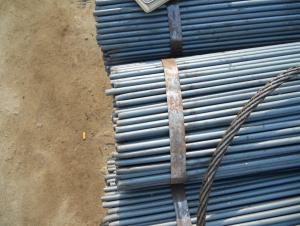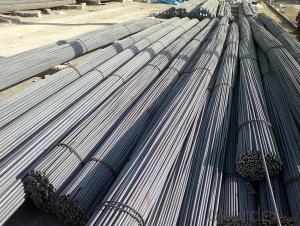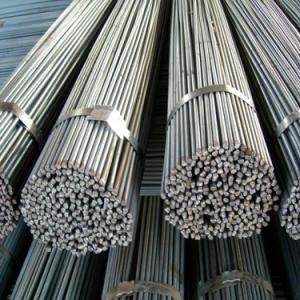Hot Rolled Carbon Steel Round Bars S40C
- Loading Port:
- Shanghai
- Payment Terms:
- TT OR LC
- Min Order Qty:
- 50 m.t.
- Supply Capability:
- 120000 m.t./month
OKorder Service Pledge
OKorder Financial Service
You Might Also Like
Hot Rolled Carbon Steel Round Bars S40C
Product Specification
1, Chemical Composition %
| Grade | C | Si | Mn | S | P | Cr | Ni | Cu |
| S40C | 0.37-0.44 | 0.17-0.37 | 0.50-0.80 | ≤0.030 | ≤0.030 | ≤0.20 | ≤0.25 | ≤0.25 |
2, Mechanical Properties
| Strength of Extension σb | Yield Strength σs | Reduction of Area ψ | impact absorbing energy |
| ≥570 Mpa | ≥335 Mpa | ≥45% | ≥47 Aku2/J |
3, Diameter: 16mm - 300mm
Length: Max 12m
Application
Used to produce axis shaft, transmission shaft, piston rod, connecting rod, chain wheel, wheel gear, etc.
Product Main Points
1, Heat Treatment: normalizing, annealing, tempering, quenching
2, Surface Treatment: black, grinding, bright, polish
3, Product Process: hot rolled, cold drawn, forged
FAQ
1, Payment Terms:
30% T/T deposit & 70% T/T before delivery.
Irrevocable L/C at sight
2, Trade Terms:
EXW, FOB, CIF, CNF
3, Delivery Time:
Normally 30-40 days. According to quantity.
4, Manufacture or Trading Company:
CNBM is a state-owned fortune global 500 trading company. We have intergrated supply system.
There are about 20 overseas locations in different countries.
Product Show

Work Shop
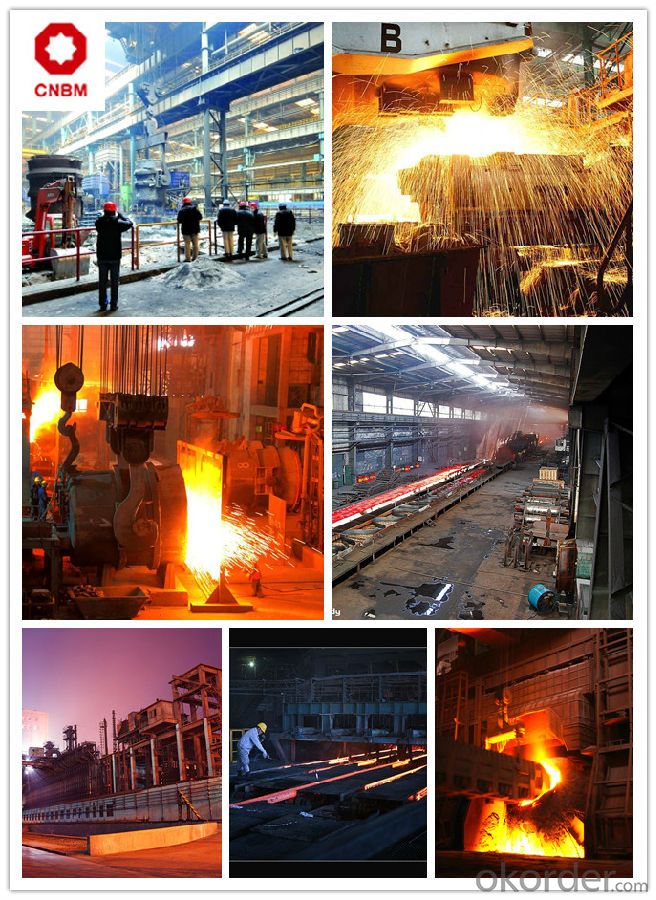
About Us

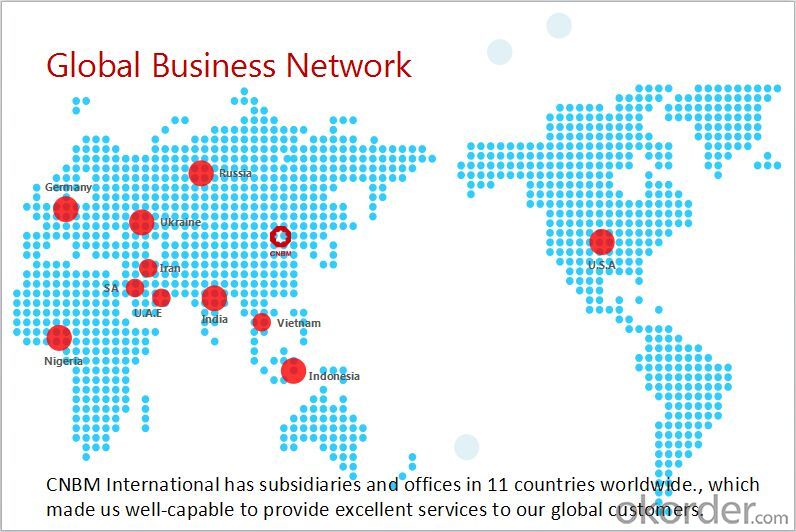
- Q:What is a steel round bar?
- A steel round bar is a solid cylindrical rod made of steel that has a circular cross-section. It is commonly used in construction, manufacturing, and machining applications due to its strength, durability, and versatility.
- Q:How do steel round bars compare to concrete round bars?
- There are several notable distinctions between steel round bars and concrete round bars. To begin with, steel round bars are composed of a robust and long-lasting material, while concrete round bars are made from a composite material containing cement, aggregates, and water. This dissimilarity in materials grants steel round bars a higher tensile strength and resistance to bending and deformation in contrast to concrete round bars, which are more susceptible to cracking and breaking under stress. Additionally, steel round bars provide greater flexibility in terms of design and customization. They can be easily molded, bent, and trimmed to specific lengths and dimensions, making them highly versatile for various applications. Conversely, concrete round bars are typically available in standard sizes and shapes, thereby limiting their design possibilities. Another crucial aspect to consider is weight. Steel round bars generally have a lighter weight compared to concrete round bars, rendering them easier to handle and transport. This weight advantage also results in reduced structural loads, allowing for more efficient and cost-effective construction. In regard to corrosion resistance, steel round bars necessitate additional protective measures such as coatings or galvanization to prevent rust and corrosion, particularly in humid or marine environments. Conversely, concrete round bars possess natural resistance to corrosion. This factor can significantly influence the long-term durability and maintenance requirements of a structure. Lastly, cost is a pivotal factor to take into account. Although steel round bars may entail a higher initial material cost compared to concrete round bars, their superior strength and durability can result in long-term cost savings. Concrete round bars may require more frequent maintenance and repairs, which can accumulate over time. In conclusion, steel round bars offer superior strength, flexibility, and durability in comparison to concrete round bars. However, the choice between the two is contingent upon the specific requirements of the project, including factors such as design flexibility, weight considerations, corrosion resistance, and cost.
- Q:How do you measure the diameter tolerance of a steel round bar?
- The diameter tolerance of a steel round bar can be measured using a caliper or micrometer tool. The tool is used to measure the diameter of the bar at multiple points along its length. The measurements are then compared to the specified diameter tolerance range to determine if the bar falls within the acceptable limits.
- Q:What's the difference between pure iron round steel and electromagnetic pure iron bar?
- One thing, one thing, the same thing is round. However, in the general industry, about 30 of the habit is called bar,
- Q:What is the difference between a hot rolled and a precision ground steel round bar?
- A hot rolled steel round bar and a precision ground steel round bar differ primarily in their manufacturing processes and resulting surface finish. Hot rolled steel round bars are produced by heating the steel billet or ingot to high temperatures and then passing it through a series of rollers to achieve the desired shape and size. This process results in a rougher surface finish with visible mill-scale or oxide layers. The hot rolling process also allows for variations in size and shape, making it a more cost-effective option for producing steel round bars in large quantities. On the other hand, precision ground steel round bars undergo a more refined and controlled manufacturing process. After the initial hot rolling, the bar is then ground to achieve a smooth and consistent surface finish. Precision grinding removes the mill-scale and oxide layers, resulting in a more polished appearance. This process also ensures a tight dimensional tolerance and improved straightness of the round bar. The choice between a hot rolled and a precision ground steel round bar depends on the specific application requirements. Hot rolled round bars are typically used in applications where surface finish is not critical, such as structural components, machinery parts, or construction materials. Precision ground steel round bars, on the other hand, are utilized in applications where a smooth surface finish, precise dimensions, and tight tolerances are necessary, such as in the manufacturing of precision tools, machinery components, or in industries like aerospace or automotive. In summary, the main difference between a hot rolled and a precision ground steel round bar lies in their manufacturing processes and resulting surface finish. Hot rolled round bars offer cost-effectiveness and versatility, while precision ground round bars provide a smoother surface finish, tighter tolerances, and improved dimensional accuracy for more demanding applications.
- Q:What are the different surface finishes for stainless steel round bars?
- Stainless steel round bars can have different surface finishes depending on the desired aesthetic appeal and functional requirements. Some of the common surface finishes for stainless steel round bars include: 1. Bright Annealed (BA): This is a smooth and highly reflective finish achieved by annealing in a controlled atmosphere. It provides a mirror-like appearance and is often used for decorative applications. 2. Mill Finish: Also known as hot rolled or hot-rolled annealed and pickled (HRAP), this is the untreated surface finish directly from the mill. It has a rough and pitted texture and is commonly used for industrial applications where appearance is not the primary concern. 3. Satin Finish: Also referred to as brushed or dull polished finish, this finish is achieved by brushing the surface of the stainless steel round bar with a fine abrasive material. It creates a soft and matte appearance with visible parallel lines. 4. Polished Finish: This finish is achieved by using progressively finer abrasive materials to polish the surface of the stainless steel round bar. It results in a high-gloss, mirror-like finish that is commonly used for decorative purposes. 5. Ground Finish: This finish is achieved by grinding the surface of the stainless steel round bar using abrasive belts or wheels. It creates a uniform and smooth surface with a matte appearance. 6. Bead Blasted Finish: This finish is achieved by bombarding the surface of the stainless steel round bar with small glass beads at high pressure. It creates a uniform and matte appearance with a slightly textured feel. 7. Electropolished Finish: This finish is achieved by immersing the stainless steel round bar in an electrolytic bath and applying an electric current. It removes a thin layer of material, resulting in a smooth and shiny surface with improved corrosion resistance. Each surface finish has its own unique characteristics and is chosen based on the specific requirements of the application.
- Q:What is the difference between a hot-rolled and a peeled steel round bar?
- The main difference between a hot-rolled and a peeled steel round bar lies in their manufacturing processes. A hot-rolled steel round bar is formed by heating a metal billet or ingot to a high temperature and then rolling it into its final shape and size. This process results in a rougher surface texture and a larger diameter tolerance. On the other hand, a peeled steel round bar undergoes an additional step called peeling after the hot-rolling process. In this step, the outer surface of the bar is removed by rotating it against a stationary cutting tool. This process improves the surface finish and dimensional accuracy of the round bar, resulting in a smoother and more precise product. In summary, while both hot-rolled and peeled steel round bars are commonly used in various industries, the peeled bar offers superior surface finish and dimensional accuracy due to the additional peeling step in its manufacturing process.
- Q:How do I determine the load capacity of a steel round bar?
- To determine the load capacity of a steel round bar, you need to consider various factors. The load capacity of a round bar depends on its diameter, length, and the type of steel used. Here are the steps to determine the load capacity: 1. Identify the steel grade: Different steel grades have different strength properties. Common steel grades include A36, A572, and 4140. Consult the specifications or consult an engineer to determine the specific grade of the steel round bar you are working with. 2. Calculate the cross-sectional area: The cross-sectional area of a round bar can be calculated using the formula A = πr², where A represents the area and r represents the radius of the round bar. Make sure to convert the diameter to radius by dividing it by 2. 3. Determine the allowable stress: The allowable stress is the maximum stress that a material can withstand before it deforms or fails. This value can be obtained from engineering handbooks or by consulting an engineer. 4. Apply the formula for load capacity: The load capacity of a round bar can be calculated using the formula Load Capacity = Allowable Stress × Cross-sectional Area. 5. Consider safety factors: In engineering applications, it is common to apply safety factors to ensure the structure's safety. These factors depend on the specific application and the level of reliability required. Consult the appropriate safety factor for your project to determine the final load capacity. It's important to note that calculating the load capacity of a steel round bar is a complex process that requires expertise in structural engineering. If you are unsure or need precise calculations, it is best to consult a qualified engineer who can provide detailed analysis based on the specific parameters of your project.
- Q:Can steel round bars be used in the production of agricultural equipment?
- Yes, steel round bars can be used in the production of agricultural equipment. Steel round bars are known for their strength, durability, and versatility, making them suitable for various applications, including agricultural equipment manufacturing. They can be used for constructing frames, supports, axles, and other components that require high strength and resistance to wear and tear.
- Q:What is the difference between a centerless ground and a rough turned steel round bar?
- The manufacturing processes and resulting surface finishes of a centerless ground steel round bar and a rough turned steel round bar differ. To produce a centerless ground steel round bar, the bar is fed through a grinding machine. This machine removes material from the surface, achieving precise diameter and roundness tolerances. The bar is rotated between two grinding wheels, while pressure is applied to remove imperfections and create a smooth, polished surface. The end result is a highly accurate and consistent diameter, with a mirror-like finish. This makes it suitable for applications that require tight tolerances and a polished appearance. On the other hand, a rough turned steel round bar is manufactured using a different machining process called turning. In this process, the bar is rotated against a cutting tool, which removes material from the surface to achieve the desired diameter and shape. However, turning does not provide the same level of precision and surface finish as centerless grinding. The resulting surface of a rough turned bar will have visible tool marks and a rougher texture compared to a centerless ground bar. In conclusion, the main distinction between a centerless ground steel round bar and a rough turned steel round bar lies in their manufacturing processes and resulting surface finishes. Centerless grinding offers a more precise diameter, roundness, and smoother surface finish, making it ideal for applications that require tight tolerances and a polished appearance. Rough turning, while less precise and with a rougher surface finish, is still suitable for applications that do not require the same level of precision or aesthetic appeal.
1. Manufacturer Overview |
|
|---|---|
| Location | |
| Year Established | |
| Annual Output Value | |
| Main Markets | |
| Company Certifications | |
2. Manufacturer Certificates |
|
|---|---|
| a) Certification Name | |
| Range | |
| Reference | |
| Validity Period | |
3. Manufacturer Capability |
|
|---|---|
| a)Trade Capacity | |
| Nearest Port | |
| Export Percentage | |
| No.of Employees in Trade Department | |
| Language Spoken: | |
| b)Factory Information | |
| Factory Size: | |
| No. of Production Lines | |
| Contract Manufacturing | |
| Product Price Range | |
Send your message to us
Hot Rolled Carbon Steel Round Bars S40C
- Loading Port:
- Shanghai
- Payment Terms:
- TT OR LC
- Min Order Qty:
- 50 m.t.
- Supply Capability:
- 120000 m.t./month
OKorder Service Pledge
OKorder Financial Service
Similar products
New products
Hot products
Related keywords



























